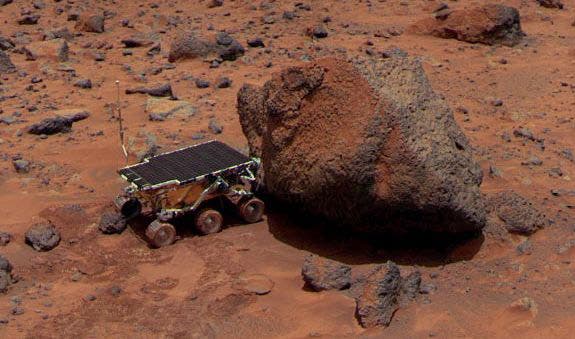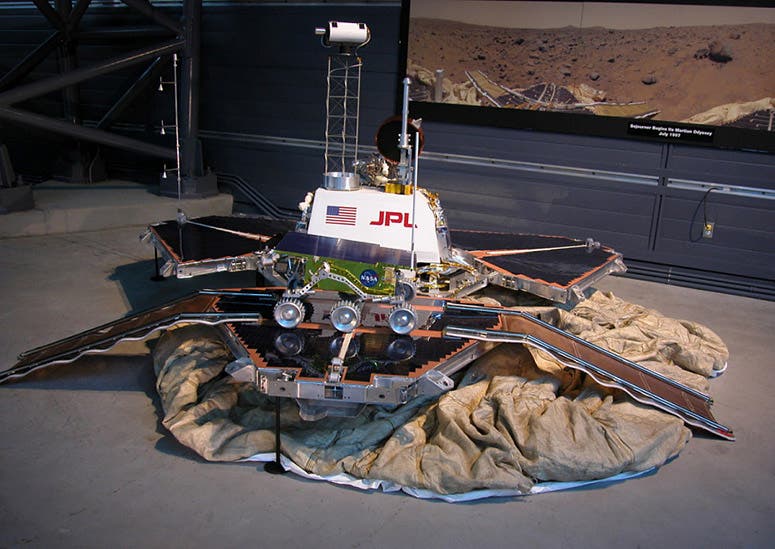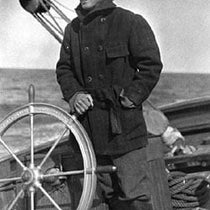Scientist of the Day - Sojourner
Sojourner, a celebrated robot and space explorer, was launched toward Mars on Dec. 4, 1996, aboard a Delta II rocket. Sojourner was the first robotic spacecraft to crawl around on an alien world and tell the folks back home about it. Sojourner was about the size of a microwave oven, with a solar-panel top surface, and powered by six wheels which turned and were driven independently. It arrived on Mars on Independence Day, 1997, riding down to the surface enfolded within the three flaps of the mother lander, Pathfinder, which itself was surrounded by a cocoon of airbags and bounced along the surface for thousands of feet before coming to rest right side up. After the bags deflated, Pathfinder spread her petals, and Sojourner powered up, wheeled down the ramp formed by the opened flaps, and proceeded to spend 3 months examining the environs around home base. Sojourner had cameras fore and aft, and a modem, and a specially designed spectrometer on its nose, with which it could determine the chemical makeup of Martian soil and rocks. Sojourner was controlled by remote drivers back at Jet Propulsion Labs (JPL) in Pasadena, who wore 3-D goggles and maneuvered a joystick like any modern-day gamer.
Sojourner's iconic moment came when it examined a Martian rock that had been named Yogi by the JPL staff. A picture (taken by Pathfinder) of this plucky robot nipping at the flanks of a much larger alien hunk of silicates was broadcast around the world and immediately endeared Sojourner to millions of new fans (second image). Had it come back to Earth, it would no doubt have enjoyed a parade down Broadway and a complete circuit of all the talk shows. But alas, both Sojourner and Pathfinder sit right where they ran out of power 25 years ago, probably buried beneath significant amounts of Martian sand.
It may be, however, that you draw your reality from the movies, in which case Sojourner is still alive for you. In the 2015 film The Martian, astronaut Mark Whatley (Matt Damon), stranded on Mars, drives his Areswagen to the Pathfinder site and retrieves both Pathfinder and Sojourner. He uses Pathfinder as a communications module so that he can get in touch with Earth, but he seems to fancy Sojourner as a pet, allowing it to roam about the "Hab." Sojourner in the film runs around at a pretty good clip, at least 5 mph. However, the real Sojourner was slow, and I mean really slow; it inched along at the rate of .015 mph, or about 16 inches per minute. In its 83 days of exploration, it covered about the length of a football field. It would only make a good pet if you liked turtles, and sluggish ones at that.
Where can you see a Sojourner? The original, on Mars, is not taking visitors. However, JPL built two Sojourners, one as a back-up, and the back-up was named Marie Curie. (The names were selected from entries submitted by students in a contest; Sojourner, the winning submission, was named after Sojourner Truth, an abolitionist, and Marie Curie, the runner-up, for the famous chemist). Marie Curie, a dead ringer for Sojourner, is on display at the National Air and Space Museum (NASM) on the Washington mall, where it is part of a display that also includes replicas or backups of the much larger Mars rovers: Spirit, Opportunity, and Curiosity (third image). If you are partial to videos, this short one provides some excellent details of the Marie Curie, and hence its twin Sojourner: JPL also built a prototype of both Pathfinder and Sojourner when it was trying to sell its design to NASA, and the prototype survives and is on display at the NASM branch at Dulles Airport, called the Udvar-Hazy Center (fourth image). And if you are happy with a good copy of the real thing, you might visit the Robot Hall of Fame at Carnegie-Mellon University in Pittsburgh, where Sojourner (or rather its stand-in) was inducted into the ranks in 2003. Or you could visit Jet Propulsion Lab in Pasadena, which has its own museum, including yet another Sojourner replica, cowering in the shadow of a replica of a Spirit/Opportunity Rover.
We will conclude with one final Sojourner photo that captured the moments when Sojourner was sealed up within the flaps of Pathfinder by a bevy of sanitized JPL scientists and technicians (fifth image). Notice it had to hunker down to fit into its temporary quarters. I wonder if anyone told Sojourner that when the flaps opened again, 7 months later, it would be 45 million miles from a home it would never see again.
William B. Ashworth, Jr., Consultant for the History of Science, Linda Hall Library and Associate Professor emeritus, Department of History, University of Missouri-Kansas City. Comments or corrections are welcome; please direct to ashworthw@umkc.edu.










![Using an astrolabe to measure the depth of a well, woodcut in Elucidatio fabricae vsusq[ue] astrolabii, by Johannes Stöffler, 1513 (Linda Hall Library)](https://assets-us-01.kc-usercontent.com:443/9dd25524-761a-000d-d79f-86a5086d4774/a998eb50-55d2-4a88-ace2-a50aa5fa86e7/Stoffler%201.jpg?w=210&h=210&auto=format&fit=crop)
